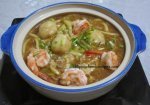Cooking Tripe
Does cooking tripe always been a challenge to you?
First, let's get to know what tripe is before we get to cooking it.
You might have the impression that tripe is a fancy ingredient because the dish Kare Kare is deemed 'special' if cooked with it, or when you hear of the dish Callos and being Spanish sounding and made with tripe - you'll think it's something served on special occasion.
Beef tripe, the most common one used in most recipes, is the lining of the cow's stomach.
It is not really white as when you buy it from the market.
Some places sell them cut in huge squares, others sell them as pictured above - like a big purse.
They're pretty much clean and safe to cook and eat if they're white and with no funky smell.
Unclean tripe is greenish in color and it will take a lot of work to get it into safe, for-human-consumption stage - so make sure you buy from a reputable store.
Before you lose your appetite and decide to omit it from your dish, just know that once you have cooked it to a really soft and tender texture, you'll forget what it actually is and where it came from.
Now, the challenge is the length of time of cooking tripe to get it in that stage.
Traditional simmering will take you hours and half a tank of gas, so we'll go the other way.
Pressure cooking!
1 Cut the tripe in desired sizes, and rinse thoroughly.
2 Boil them covered with water, then discard the water.
3 Replace the water and this time, add some salt, garlic and onion.
4 Pressure cook for 15 to 20 minutes on medium low or until the tripe is really tender.
5 Discard the liquid.
6 You can now use the tripe to cook with your favorite meat dish.
BENG'S TIPS FOR COOKING TRIPE
- I like to cut my tripe in serving sizes before cooking so they're ready to use, but not too small as they shrink during cooking.
- If you are to use the tripe for tomato based sauces, add about a tablespoon or two of white vinegar with the boiling water to taper off the smell, but still discard the water afterwards.
Return to Filipino Cooking How To's
Return to Home Page
Return to Cooking Tripe Top page


